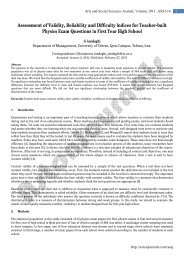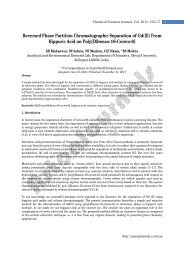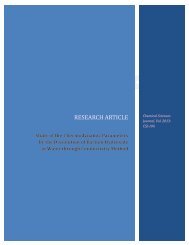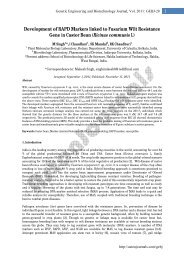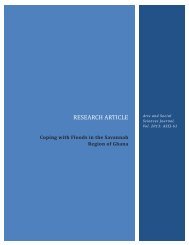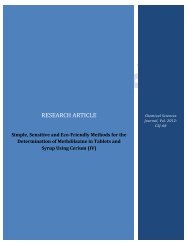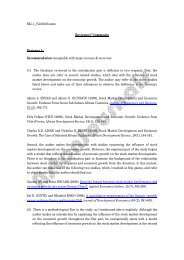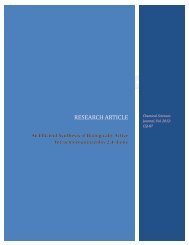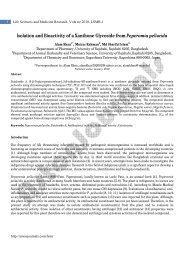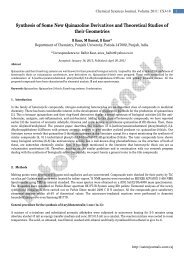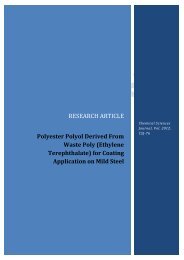[1,4]-benzodiazepine-2-one Derivatives as Potent - AstonJournals
[1,4]-benzodiazepine-2-one Derivatives as Potent - AstonJournals
[1,4]-benzodiazepine-2-one Derivatives as Potent - AstonJournals
You also want an ePaper? Increase the reach of your titles
YUMPU automatically turns print PDFs into web optimized ePapers that Google loves.
Chemical Sciences Journal, Volume 2010: CSJ-51Synthesis Of Some Novel C 3 Substituted New Diazo-[1,4]-Benzodiazepine-2-One <strong>Derivatives</strong> As <strong>Potent</strong> Anticonvulsants*Mohd. R<strong>as</strong>hid a , Ravinesh Mishra a , Asif Husain a , Bahar Ahmad ba Department of Pharmaceutical Chemistry, Faculty of Pharmacy, Hamdard University, New Delhi - 110062, Indiab Department of Antihepatotoxic Research Laboratory, Faculty of Pharmacy, Hamdard University, New Delhi - 110062,IndiaAbstract*Correspondence to: Mohd. R<strong>as</strong>hid, r<strong>as</strong>hidpharm2008@gmail.comPublished online: May 24, 2010A number of new diazonium salt derivatives of 7-chloro-5-phenyl-3-(phenyl-n-substituted)-diazo-1,3-dihydro-benzo[e][1,4]-diazepin-2-<strong>one</strong>(IVa-l) from 7-chloro-5-phenyl-1,3-dihydro-benzo[e]-[1,4]-diazepin-2-<strong>one</strong> (III) with diazonium salts (phenyl diazo salt derivatives) wereprepared and tested for anticonvulsant activity. The compounds provided significant protection against maximal electroshock induced seizures(MES) and seizures indicated by sc pentetrazole administration (sc PTZ) at 300 mg/kg after 0.5 h. The compounds IVb, IVd, and IVf were activein MES and sc PTZ indicated seizure. A conformational study of these derivatives w<strong>as</strong> undertaken to explore the mechanistic details of themode of action and their interlinked, interconvertible and energetically favored geometrical configurations acting on the receptor site.Keywords: Diazo-1,4-benzodiazepin-2-<strong>one</strong>; anticonvulsant activity; geometrical configurations; phenytoin; pentylene tetrazole (PTZ).1. IntroductionBenzodiazepines are bicyclic heterocyclic compounds possessing various types of biological activities over varied N,N-positi<strong>one</strong>dskeletal types [1-3]. Among the large number of <strong>benzodiazepine</strong>s that have been synthesized, the members of 1,4-N,N<strong>benzodiazepine</strong>group have shown sufficient pharmacological activity to warrant introduction <strong>as</strong> new drugs or templates fortranquilizing, muscle-relaxant, anticonvulsant, and sedative effects while all other <strong>benzodiazepine</strong> derivatives have marginal orno CNS related bioactivity. The use of this cl<strong>as</strong>s of bioactive derivatives with CNS therapeutic value is not only confined toanxiety and other neuronal disorders but the minor structural modifications in their structures have produced a host ofbiologically active products namely Chlordiazepoxide, Diazepam, and Nitrazepam to mention a few acting on a number of CNSrelated disorders including sleep induction. The <strong>benzodiazepine</strong>s interact with macromolecular membrane complex that h<strong>as</strong>recognition sites for GABA (-amino butyric acid) at synapses in which GABA is a neurotransmitter <strong>as</strong> a primary site of action anda chloride ionophore. The proposal by Haefely and Costa [4, 5], Sternbach and Childress [6, 7] that <strong>benzodiazepine</strong>s mayproduce their effects by enhancing GABAergic transmission provided an explanation for various other secondary alterationsinduced by these drugs in other transmitter systems. Consequently, several types of <strong>benzodiazepine</strong> receptors, over a dozen,have been identified [8, 9]. The <strong>benzodiazepine</strong>s synergistically incre<strong>as</strong>e the effects of ionotophoretically applied synaptic GABA Areceptor subtype and, similarly, elevation of brain GABA transamin<strong>as</strong>e inhibitors incre<strong>as</strong>es the electrophysiologic effects of<strong>benzodiazepine</strong>s. The GABA A receptor is a ligand-gated chloride ion channel and is proteinaceous in nature which is anchored inthe cell membrane and is pentomeric. Different receptor subtypes are located in different parts of the brain <strong>as</strong> well <strong>as</strong> scatteredin spine. The GABA A h<strong>as</strong> profound bearings on the pharmacological response of the <strong>benzodiazepine</strong>s. The 1,4-<strong>benzodiazepine</strong>sare positive modulators or agonists and enhance the effect of GABA binding to GABA A sites to incre<strong>as</strong>e the chloride ion flux intothe neuron.Thus, the diminishing receptor binding or inhibition of GABA synthesis can abolish <strong>benzodiazepine</strong> related side effects. Theincre<strong>as</strong>ed <strong>benzodiazepine</strong> binding caused by GABA also involves the chloride ion that act synergistically with GABA. The bindingof drugs to GABA or chloride ionophore can allosterically modify the <strong>benzodiazepine</strong> receptors, cl<strong>as</strong>sified <strong>as</strong> BZ 1 and BZ 2 , and thedrug may elicit their action by direct occupation of the <strong>benzodiazepine</strong> receptor BZ 1 or interaction with GABA-chlorideionophore by allosteric interaction complex. The metabolism of these cl<strong>as</strong>ses of compounds h<strong>as</strong> been extensively studied andmethods for their analytical detection and blood levels determination have been reported while studying the neurotoxicity<strong>as</strong>sociated. We approached to synthesize these compounds with modified structures for stereochemically flexible andinterconvertible geometries with an aim for prolonged retention by incre<strong>as</strong>ing polarity, improved water solubility, lessermetabolic degradation, better brain impermeation with specified lipophilic endings and better p<strong>as</strong>s-out abilities in metabolicallychallengedsubjects [10-13].http://<strong>as</strong>tonjournals.com/csj
4 Research Article7-Chloro-3-[(3-methylphenyl) diazenyl]-5-phenyl-1,3-dihydro-1H,3H-1,4-benzodiazepin-2-<strong>one</strong> IVkYield: 58%; m.p.: 234-236; R f value 0.55; Log P: 6.65; FTIR (KBr) ν max [cm -1 ]: 3150-3090 (N-H str ), 2930 (Ar-CH 3 ), 2190-2150 (N=N- str ),2050-2010 (-CH N=N str ), 1700 (C=O str ), 1650 (Ar C=C str Bz), 1550 ( C=N str ), 1375 (C-N str ), 630 (ArC-Br str ); 1 H-NMR (DMSO-d6) d[ppm]: 1.72 (brs, 3H, Bz,), 2.60 (s, 1H, Ar-CH 3 ), 5.02 (s, 1H, Ar-NH), 7.14-8.10 (6 brm, 12H, Ar-H); MS [m/z]: 388/390 (M + / M + +2).Anal. Calcd. for C 22 H 17 ClN 4 O: C, 67.95; H, 4.41; N, 14.41. Found: C, 67.93; H, 4.40; N, 14.40.7-Chloro-3-[(4-methylphenyl) diazenyl]-5-phenyl-1,3-dihydro-1H,3H-1,4-benzodiazepin-2-<strong>one</strong> IVlYield: 60%; m.p.: 233-235; R f value 0.54; Log P: 6.65; FTIR (KBr) ν max [cm -1 ]: 3220-3050 (N-H str ), 2950 (Ar-CH 3 ), 2250-2150 (N=N str ),2050-2010 (-CH N=N str ), 1700 (C=O str ), 1650 (Ar C=C str Bz), 1550 ( C=N str ), 1375 (C-N str ), 630 (ArC-Br str ); 1 H-NMR (DMSO-d6) d[ppm]: 1.52 (brs, 3H, Bz,), 2.58 (s, 1H, Ar-CH 3 ), 5.02 (s, 1H, Ar-NH), 7.14-8.10 (6 brm, 12H, Ar-H); MS [m/z]: 388/390 (M + / M + +2).Anal. Calcd. for C 22 H 17 ClN 4 O: C, 67.95; H, 4.41; N, 14.41. Found: C, 67.93; H, 4.40; N, 14.40.2.4 Anticonvulsant ActivityMale albino mice weighing between 25-30 g were used for grandmal type of epileptic conditions [21]. They were housed ingroups of three or four mice per cage under standard laboratory conditions maintained at 25 o C and humidity at 45-50% for <strong>one</strong>week before anti-convulsant activity w<strong>as</strong> carried out by using both Maximal Electroshock (MES) and PTZ animal models. Foodand water were withdrawn prior to the experiment. All the result which obtained in both the method w<strong>as</strong> statistically analyzedand results expressed <strong>as</strong> mean ± S.E.M.2.4.1 Maximal Electro Shock (MES) ModelThe MES induced convulsions were divided into five ph<strong>as</strong>es <strong>as</strong>: Tonic flexion, Tonic extension, clonic convulsion, Stupor,Recovery or death. A substance is known to possess anticonvulsant property if it reduces or abolishes the extensor ph<strong>as</strong>e. Thestandard drug phenytoin and test compounds were dissolved (20 mg/kg) in propylene glycol and administered intraperit<strong>one</strong>ally30 min. before the test using electroconvulsometer for the observation by electroshock seizure method. Animals were subjectedto supra maximal electroshock of 50 mA, 60Hz alternating current from a convulsometer for 0.2 sec through a pair of electrodesattached to each ear. The duration of the tonic hind limb extensor ph<strong>as</strong>e, clonic ph<strong>as</strong>e and the number of animals protectedfrom convulsions were noted. The Results were shown in Table 1.All the tested compounds showed a reduction in the duration of tonic hind limb extensor ph<strong>as</strong>e. A complete abolition of hindlimb tonic extensor w<strong>as</strong> considered <strong>as</strong> 100% protection while the abolition of the hind limb tonic extensor sp<strong>as</strong>m w<strong>as</strong> recorded<strong>as</strong> an incre<strong>as</strong>ed anticonvulsant activity [22, 23].2.4.2 PTZ Animal ModelPentylene tetrazole (PTZ) produced clonic convulsions prevented by drugs effective in absences of seizures in this modelrepresented action on seizures focus. PTZ (Sigma-Aldrich, Milwaukee WI, USA) w<strong>as</strong> used to produce convulsion and Diazepam(Ranbaxy Laboratories, New Delhi, India) w<strong>as</strong> used <strong>as</strong> standard drug dissolved in 2% gum acacia suspension [24, 25]. The animalswere divided into fourteen groups of six mice in each group. The convulsions were induced 1 hr after administration of thestandard drug or the test compounds by i.p. injection of (80 mg/kg) which w<strong>as</strong> dissolved in saline at a volume of 0.1 ml/10gmbody weight ratios. The time needed for the development of unequivocal sustained clonic seizure activity involving the limbs(isolated myoclonic jerks or other preconvulsion chewing behavior were not counted) w<strong>as</strong> carefully noted. The duration ofseizure w<strong>as</strong> also recorded. The seizures free duration for a period of 1 hour w<strong>as</strong> taken <strong>as</strong> protection. The number of animalsprotected in each group w<strong>as</strong> also recorded and percent protection w<strong>as</strong> calculated. The data were summarized in Table 2.3. Results and Discussion3.1 ChemistryThe novel 3-diazo derivative of 7-Chloro-5-phenyl-1,3-dihydro-1H,3H-1,4-<strong>benzodiazepine</strong>-2-<strong>one</strong> emerged <strong>as</strong> promisinganticonvulsant agents with CNS anti-depressant activity which are analogous to oxazepam, diazepam and lormetazepam inactivity. The earlier structure-activity relationship studies [14-16] on 5-phenyl-1,4-benzodiazepin-2-<strong>one</strong>s have revealed that thecompounds having electron withdrawing substituent like chloro, bromo, nitro, triflouromethyl and cyano groups at position C 7 ,small polar/hydrophilic substitutions at position C 3 and chloro, bromo or flouro substitutions at position C 2’ in the C 5 phenyl ringof the 1,4-<strong>benzodiazepine</strong> skeleton may enhance anti-convulsant activity where<strong>as</strong> substitutions at all other positions except forposition N 1 for methyl linked to the nitrogen atom (N-CH 3 ) will result in loss/decre<strong>as</strong>e of activity along with the introduction ofhttp://<strong>as</strong>tonjournals.com/csj
Chemical Sciences Journal, Volume 2010: CSJ-55electron donators at any 1,4-<strong>benzodiazepine</strong> substitutions. The various derivatives of substituted new Diazo-[1,4]-<strong>benzodiazepine</strong>-2-<strong>one</strong> were synthesized <strong>as</strong> shown in Figure 1.OClNH 2O+ Cl C H 2 C ClT o lu e n eClICO ClNH-C-CH2 ClAl C l 3 /C C l 4HNOH e xa m in eONH-C-CH2 ClClNNH 4 ClClOCIICH 3 C O 2 NaII IN 2 ClClHNNONRNRIV a -lFigure 1. Synthesis protocol for novel C 3 substituted new Diazo-[1,4]-<strong>benzodiazepine</strong>-2-<strong>one</strong> derivatives.Moreover, the replacement/removal of lipophilic phenyl group at position C 5 by other substituent or hydrogen also decre<strong>as</strong>esthe pharmacological activity. Interestingly, the other substitutable active methylene group containing position C 3 have not beenstudied widely in this cl<strong>as</strong>s for their SAR which needed further elaboration with regard to the substituent effects on thepharmacological activity vis a vis the stereo-electronic behavior of the C 3 substituent’s and the internal substitutionalreplacements with the group attached to C 3 . Hence, we, concentrated on synthesizing some new 7-chloro-3-diazo derivatives of5-phenyl-1,3-dihydro-[1H,3H]-1,4-N,N-<strong>benzodiazepine</strong>-2-<strong>one</strong> compounds with C 3 substitutions also displaying the internalsubstitution patterns at positions C 2’’ , C 3’’ and C 4’’ and their stereo-electronic effects on their anticonvulsant activities.3.2 Anticonvulsant activityThe products with diazonium moiety <strong>as</strong> 3-(4-chlorodiazonium salt) (IVb), 3-(4-floro diazonium salt) (IVd), 3-(4-nitrodiazoniumsalt) (IVf) and 3-(2-chlorodiazonium salt) of 7-Chloro-1,4-<strong>benzodiazepine</strong>-2-<strong>one</strong>-5-phenyl (IVj) had shown excellentanticonvulsant activity in comparison with standard drug diazepam, used in the PTZ animal model. The substitution of anilinecontaining moiety at position C 4 with flouro, chloro, nitro group and 2-chloro w<strong>as</strong> employed. The substitution of aniline moietyat C 4 in the synthesis of diazonium salt enhanced the activity in c<strong>as</strong>e of corresponding compounds (IVb, IVd, IVf). Since thesecompounds (IVb, IVd, IVf) contained electron withdrawing group at position C 4 , showed the higher order of activity <strong>as</strong> predictedearlier. The higher-end biological activity of the compound (IVj) is due to presence of chlorine substitution at position C 2 . So thecompounds (IVb, IVd, IVf, IVj) were more effective than compounds (IVc, IVe, IVg, IVi). The compounds (IVb, IVd, IVf, IVj) werefurther studied and have shown anti-anxiety, anti-depressant activities and neurotoxicity elevation effects. Some of thehttp://<strong>as</strong>tonjournals.com/csj
8 Research Article4. Competing InterestsThe authors declare that they have no competing interests.5. Authors’ ContributionsMR and BA developed the project and supervised preparation of the manuscript; RM <strong>as</strong>sisted with preparation of themanuscript, sample collection and data analysis; AH <strong>as</strong>sisted with spectral analysis and biological activity.6. AcknowledgementWe express our thanks to Head, Department of Pharmaceutical Chemistry, Hamdard University, New Delhi for <strong>as</strong>sistance duringthe course of this study.References[1] Sternbach LH, 1971. 1,4-Benzodiazepines: Chemistry and some <strong>as</strong>pects of the structure activity relationship. AngewandteChemie International Edition, 10: 34–40.[2] Walsh DA, 1980. The synthesis of 2-aminobenzophen<strong>one</strong>s. Synthesis, 9: 677–688.[3] Evans BE, Rittle KE, Bock MG, Pardo RMD, Freidinger RM, Whitter WL, Lundell GF, 1988. Methods for drug discovery—Development of point, selective, orally effective cholecystokinin antagonist. Journal of Medicinal Chemistry, 31: 2235–2246.[4] Patchett AA, Nargund RP, 2000. Privileged structures-An update. Annual Reports on Medicinal Chemistry, 35: 289–298.[5] Sternbach LH, 1979. Benzodiazepine story. Journal of Medicinal Chemistry, 22: 1–7.[6] Herrero S, Garcy MT, Herranz R, 2003. Expedient <strong>one</strong>-pot synthesis of novel chiral 2-substituted 5-phenyl-1,4-<strong>benzodiazepine</strong>scaffolds from amino acid–derived amino nitriles. Journal of Organic Chemistry, 68: 4582–4585.[7] Hanley DF, Pozo M, 2000. Treatment of satus epilepticus with midazolam in the critical care setting. International Journal ofClinical Practice, 54: 30–35.[8] Hsu MC, Schutt AD, Holly M, Slice LW, Sherman MI, Richman DD, Pot<strong>as</strong>h MJ, Volsky DJ, 1991. Inhibition of HIV replication inacute and chronic infections in vitro by a TAT antagonist. Science, 254: 1799–1802.[9] Selnick HG, Liverton NJ, Baldwin JJ, Butcher JW, Claremon DA, Elliott JM, Freidinger RM, 1997. Cl<strong>as</strong>s III anti-arrhythmicactivity in vivo by selective blockade of the slowly activating cardiac delayed rectifier pot<strong>as</strong>sium current IKs by (R)-2-(2,4-trifluoromethyl)-N-[2-oxo-5phenyl-1-(2,2,2-trifluoroethyl)-2,3-dihydro-1Hbenzo[e][1,4]diazepin-3-yl]acetamide. Journal ofMedicinal Chemistry, 40: 3865–3868.[10] James GL, Goldstein JL, Brown MS, Rawson TE, Somers TC, McDowell RS, Crowley CW, Luc<strong>as</strong> BK, Levinson AD, Marsters JC,1993. Benzodiazepine peptidomimetics—<strong>Potent</strong> inhibitors of r<strong>as</strong> farnesylation in animal cells. Science, 260: 1937–1942.[11] Liskamp RM, 1994. A new application of modified peptides and peptidomimetics-<strong>Potent</strong>ial anticancer agents. AngewandteChemie International Edition, 33: 305–307.[12] Wyatt PG, Allen MJ, Chilcott J, Hickin G, Miller ND, Woollard PM, 2001. Structure-activity relationship investigations of apotent and selective <strong>benzodiazepine</strong> oxytoxin antagonist. Bioorganic and Medicinal Chemistry Letter, 11: 1301–1305.[13] Dziadulewicz EK, Brown MC, Dunstan AR, Lee W, Said NB, Garratt PJ, 1999. The design of non-peptide human bradykinin B-12 receptor antagonists employing the <strong>benzodiazepine</strong> peptidomimetic scaffold. Bioorganic and Medicinal Chemistry Letter, 9:463–468.[14] Anzini M, Canullo L, Braile C, Cappelli A, Gallelli A, Vomero S, Menziani MC, Benedetti PGD, Rizzo M, 2003. Synthesis,biological evaluation, and receptor docking simulations of 2-[(acylamino)ethyl]-1,4-<strong>benzodiazepine</strong>s <strong>as</strong> opioid receptor agonistsendowed with anti-nociceptive and anti-amnesic activity. Journal of Medicinal Chemistry, 46: 3853–3864.http://<strong>as</strong>tonjournals.com/csj
Chemical Sciences Journal, Volume 2010: CSJ-59[15] Buck IM, Black JW, Cooke T, Dunst<strong>one</strong> DJ, Gaffen JD, Griffin E, Harper EA, Hull RAD, Kalindjian SB, Lilley EJ, Linney ID, 2005.Optimization of the in vitro and in vivo properties of a novel series of 2,4,5-trisubstituted imidazoles <strong>as</strong> potent cholecystokinin-2(CCK2) antagonists. Journal of Medicinal Chemistry, 48: 6803–6812.[16] Semple G, Ryder H, Rooker DP, Batt AR, Kendrick DA, Szelke M, Ohta M, Satoh M, Nishiha A, Akuzawa S, Miyata K, 1997.(3R)-N-(1-(tert-Butylcarbonylmethyl)-2,3-dihydro-2-oxo-5-(2-pyridyl)-1H-1,4-benzodiazepin-3-yl)-N0-(3-(methylamino)phenyl)urea (YF476): A potent and orally active g<strong>as</strong>trin/CCK-B antagonist. Journal of Medicinal Chemistry, 40: 331–341.[17] Micale N, Vairagoundar R, Yakovlev AG, Kozikowski AP, 2004. Design and synthesis of a potent and selective peptidomimeticinhibitor of c<strong>as</strong>p<strong>as</strong>e-3. Journal of Medicinal Chemistry, 47: 6455–6458.[18] Sternbach LH, Fryer RI, Metlesics W, Reeder E, Sach G, Saucy G, Stempel A, 1962. Quinazolines and 1,4-<strong>benzodiazepine</strong>s, VI:Halo-, methyl-, and methoxy-substituted 1,3-dihydro-5-phenyl-2H-1,4-benzodiazepin-2-<strong>one</strong>s. Journal of Organic Chemistry, 27:3788–3796.[19] Bolli MH, Marfurt J, Grisostomi C, Boss C, Binlcert C, Hess P, Treiber E, Thorin A, Morrison K, Buchmann S, Bur D, Ramuz H,Clozel M, Fischli W, Weller T, 2004. Novel benzo[1,4]diazepin-2-<strong>one</strong> derivatives <strong>as</strong> endothelin receptor antagonists. Journal ofMedicinal Chemistry, 47: 2776–2795.[20] Robl JA, Cimarusti MP, Simpkins LM, Brown B, Ryono DE, Bird JE, Asad MM, Schaeffer TR, Trippodo NC, 1996. DualMetalloprote<strong>as</strong>e Inhibitors. 6. Incorporation of Bicyclic and Substituted Monocyclic Azepin<strong>one</strong>s <strong>as</strong> Dipeptide Surrogates inAngiotensin-Converting Enzyme/Neutral Endopeptid<strong>as</strong>e Inhibitors. Journal of Medicinal Chemistry, 39: 494-502.[21] Gilman WN, Rosen P, James V, Cook C, 2004. Atropisomers of 1,4-<strong>benzodiazepine</strong>s. Synthesis and resolution of a diazepamrelated1,4-<strong>benzodiazepine</strong>. Journal of American Chemical Society, 112: 3969- 3978.[22] Vijaya RK, Ashalatha BV, Narayana B, 2006. Synthesis of some new substituted triazolo [4,3-a][1,4] <strong>benzodiazepine</strong>derivatives <strong>as</strong> potent anticonvulsants. European Journal of Medicinal Chemistry, 41: 417-422.[23] Kral AC, Penny JK, While BG, Kupferlerg HG, Swingard EA, 1978. Antiepileptic drug development II. Anticonvulsant drugscreening. Epilepsia, 19: 409-428.[25] Luna LG, 1968. Manual of Histological Staining Methods of the Armed Forces Institute of Pathology, 3rd ed., McGraw-Hill,New York, 567-580.http://<strong>as</strong>tonjournals.com/csj


![[1,4]-benzodiazepine-2-one Derivatives as Potent - AstonJournals](https://img.yumpu.com/49117784/1/500x640/14-benzodiazepine-2-one-derivatives-as-potent-astonjournals.jpg)
